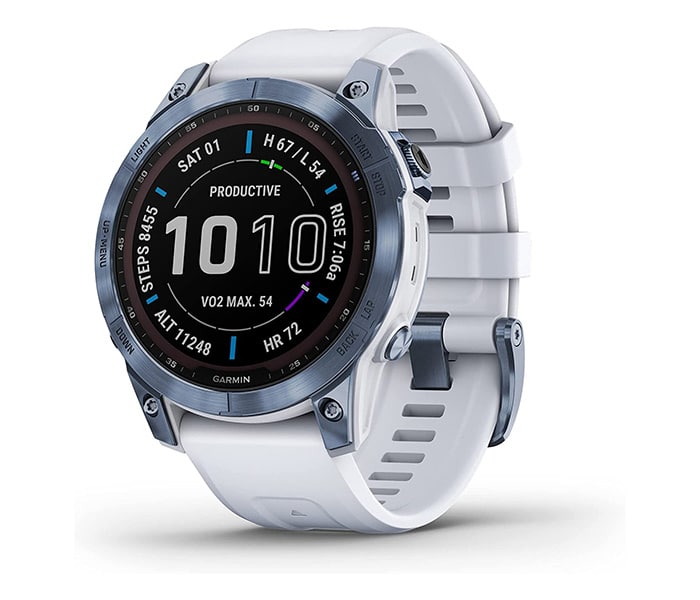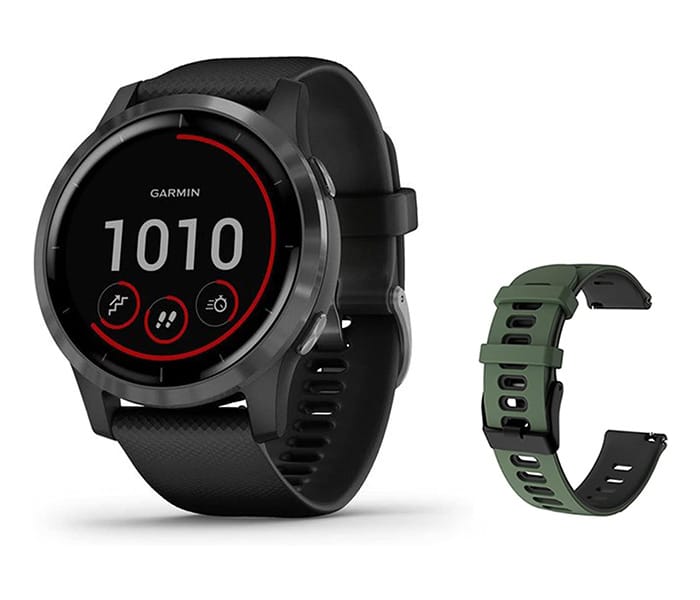A fitness tracker is a device or application that allows you to monitor and track your physical activity, such as the number of steps you take, the distance you travel, the number of calories you burn, and your heart rate.
These devices can be worn on your wrist, clipped to your clothing, or carried in a pocket or bag.
6 best fitness trackers without subscription
1. Amazfit Band 5

The Amazfit Band 5 is a great fitness tracker for those on a budget, offering a robust collection of tracking features without a subscription.
The device comes with many of the features found on most fitness trackers, such as a heart rate monitor, sleep tracking, activity tracking, and more. However, it also has a few extras, such as oxygen saturation monitoring, women’s health tracking, and compatibility with Amazon Alexa.
The device can run between a week and a half and two weeks on a single charge, depending on how often you wear it and how you utilize its features.
It’s compatible with both Android and iOS devices and is water-resistant up to 50 meters.
Pros
- Durable construction
- No subscription required
- Long battery life
- Compatible with Amazon Alexa
- Onboard women’s health tracking
Cons
- Error-prone oxygen saturation tracking
- No onboard GPS
2. Garmin fenix 7

The Garmin Fenix 7 is a sleek fitness tracker with a lot of features. The large 1.3-inch Transflective MIP display is always-on and scratch-resistant, with a Solar Powered lens to extend battery life.
Garmin has included a number of special features like Backcountry Ski, XC Ski Dynamics, Surf-Ready Features, MTB Dynamics, HIIT Workouts, Daily Workout Suggestions, Visual Race Predictor and PacePro Technology.
For wrist-based health and wellness monitoring, the Fenix 7 offers hr and pulse ox monitoring, stress and enhanced sleep tracking.
It comes preloaded with maps for thousands of golf courses and ski resorts worldwide, plus multi-band frequency and GNSS network support for high accuracy positioning.
The garmin fenix 7 also added Wi-Fi connectivity, allowing you to download maps, plus you can receive smart notifications and use contactless payments with Garmin Pay.
Pros
- Large 1.3-inch Transflective MIP display
- Solar Powered lens to extend battery life
- Backcountry Ski, XC Ski Dynamics and Surf-Ready Features
- Wrist-based hr/ox monitoring and stress monitoring
- Preloaded TopoActive maps
- Built-in Wi-Fi connectivity
- Garmin Pay contactless payment solution
Cons
- Pricey
3. Amazfit GTS 3 Smart Watch

The Amazfit GTS 3 smartwatch provides a host of features with no subscription. It offers an impressive number of UIs and navigations with its Zepp OS, which consumes only a small amount of power. With an ultra HD AMOLED display and rotatable crown, it’s a stylish device with an always-on display.
This watch has more than 150 sports modes for tracking various activities and metrics like heart rate, maximum oxygen uptake (VO2 max), calories burned, and more. It is also water-resistant up to 5 ATM, making it suitable for swimming.
The watch also has access to Alexa with an offline voice function to help you set alarms, ask questions, and use other features without an internet connection. You can also test your heart rate, blood-oxygen saturation, stress level, and breathing rate with a single tap of the watch.
Pros
- Powered by the Zepp OS
- AMOLED display with rotatable crown
- More than 150 sports modes
- Access to Alexa
- Supports GPS and GLONASS navigation systems
Cons
- Battery life could be better
4. Garmin Forerunner 245

The Garmin Forerunner 245 Music is a feature-rich fitness tracker with music and advanced training features. It includes a 1.2-inch color display as well as up to 7 days of battery life in smartwatch mode and 6 hours in GPS mode with music.
The Forerunner 245 also offers advanced running dynamics with options for ground contact time balance, stride length, vertical ratio, and more when paired with compatible running dynamics pods or HRM-run or HRM-Tri monitors.
The watch can also sync with music streaming services such as Spotify to easily store your favorite songs and play them from your wrist. Other features include incident detection which sends your real-time location to emergency contacts when using select activities, and free adaptive training plans from Garmin Coach or the ability to create your own custom workouts on the Garmin Connect online fitness community.
Pros
- Color display
- Multiple training features
- Storage for music
- Incident detection
Cons
- Requires compatible accessories for advanced running dynamics
- Music streaming only works with select services
5. Garmin vívoactive 4

The Garmin Vivoactive 4 is an all-in-one fitness tracker that doesn’t require a subscription. This watch does everything you would expect from a fitness watch, including tracking steps, calories and heart rate. It also comes equipped with 20+ built-in sports apps, so you can track a wide range of activities from running to skiing and golfing.
The Vivoactive 4 is also capable of playing music offline, so you can leave your phone behind while you’re working out. And with its battery life of up to 8 days in smartwatch mode and up to 6 hours in GPS mode with music, you won’t have to worry about it running out of juice too quickly.
It also features wireless notifications, email, text messaging and use of a compatible Android phone.
The Vivoactive 4 is an excellent fitness tracker for all levels of fitness, so you won’t need to purchase any subscription to get the most out of it.
Pros
- No subscription needed
- Many sports apps
- Wireless notifications
- Music playback
- Excellent battery life
Cons
- No ECG/EKG
- No advanced health metrics
6. Fitpolo Smart Watch

The Fitpolo Smart Watch is packed with features, including a full TFT-LCD touch display, a heart rate monitor and multi-sport modes.
It is also waterproof and has an impressive seven days of battery life, so you don’t have to worry about running out of power while swimming or while on long hikes.
The device can be synced with a smartphone to access notifications and use the included VeryFitPro app to track health and fitness metrics.
The app can also be used to set alarms, adjust music, and even display workout routes.
Pros
- Full display screen
- Multi-sport modes
- Waterproof
- Seven days of battery life
- Can connect to smartphones
Cons
- Cannot reply to messages or make calls
How do fitness trackers help monitor your health and fitness?
Fitness trackers can be a useful tool for monitoring and improving your health and fitness. By providing real-time feedback on your physical activity, they can help you set and achieve fitness goals, such as walking a certain number of steps per day or burning a certain number of calories. They can also motivate you to be more active and make healthier choices.
In addition to tracking your physical activity, some fitness trackers also have other features, such as sleep tracking, GPS tracking for outdoor activities, and the ability to connect with other fitness apps or devices.
Overall, fitness trackers can be a valuable tool for anyone looking to improve their health and fitness by monitoring and tracking their physical activity.
What are fitness tracker subscriptions and their potential drawbacks?
Some fitness tracker companies offer subscription plans that provide additional features or services. For example, a subscription may give you access to advanced tracking and analysis tools, personalized workout plans, or the ability to connect with a fitness coach or personal trainer.
One potential drawback of fitness tracker subscriptions is the cost. These subscription plans can add up over time, and some people may find that the cost is not justified by the added features or services.
Another potential drawback is the potential for data privacy concerns. When you sign up for a fitness tracker subscription, you may be asked to provide personal information, such as your name, age, gender, and health data.
It’s important to carefully read the terms of service and privacy policy to understand how your data will be used and shared.
Overall, the decision to sign up for a fitness tracker subscription is a personal one and will depend on your individual needs and preferences. It’s important to carefully consider the costs and potential drawbacks before making a decision.
What to look for in a fitness tracker
When shopping for a fitness tracker, it’s important to consider the features you need and the design that will work for you. Factors to consider include:
1. Battery life
Look for a device that has a long battery life so you don’t have to worry about charging it too often. The average battery life for most trackers is around 7 days or more.
2. Water resistance
If you plan on using the device for activities like swimming, look for one with a water resistance rating of at least 50 meters.
3. Display
If you want the device to be visible in bright light and darkness, look for one with a color display.
4. Heart rate tracking
If you want to track your heart rate during activities, look for a device that has an optical heart rate monitor.
5. GPS
If you plan on running outdoors, look for a fitness tracker that includes GPS.
6. Other features
Other features to look for include activity tracking, sleep tracking, and additional features such as music control and notifications.
Conclusion
When shopping for a fitness tracker, it’s important to consider your needs and the features offered. For those looking for a fitness tracker with no subscription, the Amazfit Band 5, Garmin Fenix 7, Amazfit GTS 3 Smart Watch, Garmin Forerunner 245, Garmin Vivoactive 4 and Fitpolo Smart Watch all offer a variety of features without a subscription.
No matter which fitness tracker you choose, all of these trackers offer great features and have something that will appeal to anyone looking to track and monitor their health and fitness.